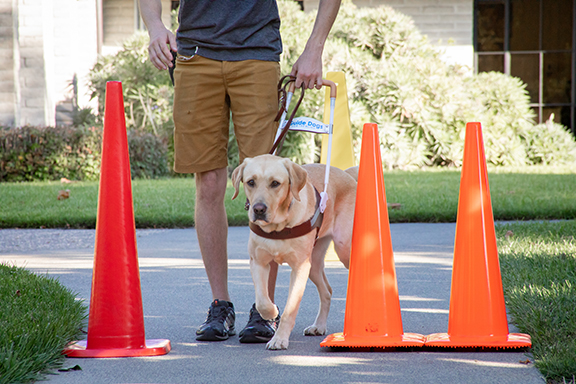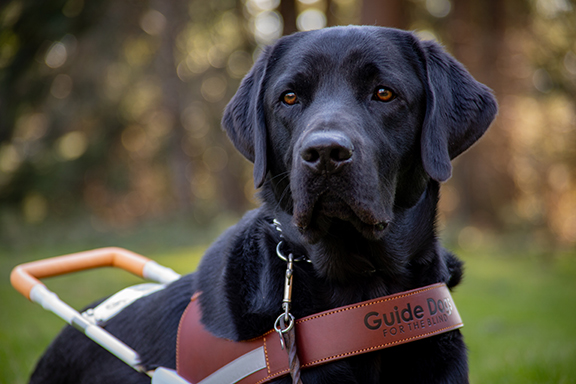While the guide dog users in this study shared a number of reasons for choosing to use a guide dog, others shared an equally broad number of reasons for not using one. Our research study included a combination of current guide dog users, former guide dog users, and guide dog nonusers, enabling us to gather information about the reasons shaping people’s choices not to use a guide dog either temporarily or permanently.
Responsibilities and Financial Burdens With Using a Guide Dog
In our survey, individuals who did not use a guide dog were asked why they did not use one. Among the 236 respondents, the top reason for not using a guide dog, according to 74 respondents (31%), was “not wanting the responsibility of caring for a dog.” Another 53 respondents (22%) stated that they did not have the financial resources to afford a guide dog.
Focus group participants who did not use guide dogs echoed these sentiments, often adding that they were simply not “an animal person” or they did not want the commitment and responsibility of ongoing dog care. Some individuals cited competing life demands that made guide dog usage less viable. For example, a parent of young children explained:
“I just can’t imagine fitting a fur child into my life, now or maybe ever.”
Notably, some guide dog schools pay for veterinary expenses, which can mitigate the financial obligations of having a guide dog. Some focus group participants utilized and appreciated this financial assistance. However, others preferred to attend a school that gave them full ownership of their guide dog, even though those schools typically do not provide as much financial support.
Limited Walking Opportunities
As discussed earlier, individuals who have limited opportunities to walk may simply not need a guide dog nor be able to provide the daily work that a guide dog requires. A variety of lifestyle factors may influence an individual’s activity level, including the location where they live, their employment status and the type of job held if employed, and the extent to which they engage in longer-distance travel. Even individuals who would otherwise be strong candidates for a guide dog may simply be unable to use a guide dog if they do not live in a walkable neighborhood. As one participant explained:
“When I got [my former guide dog], I lived in a house with a yard, just wonderful neighborhood for walking…and then, my situation…was going to change…and the only place that I can afford here is in a building downtown. I’m not comfortable getting another dog where I’m living…I would absolutely get another dog…if I lived in a [walkable] neighborhood.”
Among the guide dog nonusers surveyed, 23% stated they did not use a guide dog because their walking and travel activities were limited.
Concerns About Usable Vision
Guide dog schools in the United States and Canada typically have eligibility criteria related to level of usable vision, such as a requirement that applicants must be legally blind. While some individuals who apply for a guide dog are turned away because they do not meet these criteria, others may mistakenly believe that they have too much usable vision to benefit from a guide dog. Our interview participants with low vision sometimes expressed a belief that they could be “taking a dog from someone who needs it” by applying. One participant said:
“[People with low vision] could benefit. It’s always been a misconception that you had to have some level of acuity…so I never really entertained the idea of applying for one. I saw it as taking it from someone who really needed it… I probably wouldn’t [get a guide dog] now. But if my vision kept declining, or if I ever felt like it was a safety thing for me, [I might].”
Another participant, who has low vision and uses a guide dog, added:
“I think, so often O&M people say to someone with low vision, ‘Well, you have too much vision for a dog.’ My O&M teacher told me that … years ago, and it took a long time for someone to convince me that he was wrong.”
In some cases, individuals with low vision may qualify and benefit from partnering with a guide dog, but they may erroneously believe that they would not benefit or that they should not apply. Education and outreach toward people with low vision may enable more individuals to receive the benefits of a guide dog or, if they do not qualify, to connect with other O&M resources that could help maximize their independence.
Challenges of Transitioning from One Dog to the Next
When a partnership is ended with a guide dog, whether it is through death or retirement of the dog, some challenges often occur. In past studies, guide dog users have typically reported having good experiences with their first dog and, as a result, often feel sad, resigned, or guilty with their second dog which impacts bonding (Ward & Peirce, 2010). Guide dog users also reported that the second dog often seems to require more concentration and greater physical demands. This may occur because guide dog users may need to refresh their own O&M skills and then develop new habits and routines with a new dog. Changes in usable vision can also complicate retraining (Ward & Peirce, 2010). Participants in our study echoed these experiences, and several shared that they decided to take a break between guide dogs for these reasons. Some individuals may also decide not to get a subsequent guide dog at all after a particularly challenging guide dog loss. Generally, it is thought that more care and focus need to be placed on the emotional consequences of guide dog partnerships and retraining (Nicholson, Kemp-Wheeler, & Griffiths, 1995).
Study participants, especially in the interviews and focus groups, provided valuable feedback on strategies for successful outreach to prospective clients. Key issues to consider include the following: family and cultural factors, factors influencing school choice, collaboration with O&M instructors, and attention to messaging used by guide dog schools.

